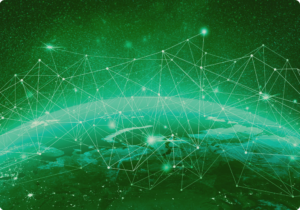 Blockchain and the environment are natural allies. In an age where the future of technology and the future of our planet go hand-in-hand, it feels more essential than ever before to invest in systems that reduce the carbon footprints of all the processes we take for granted.
Blockchain and the environment are natural allies. In an age where the future of technology and the future of our planet go hand-in-hand, it feels more essential than ever before to invest in systems that reduce the carbon footprints of all the processes we take for granted.
How can bitcoin mining help in the climate crisis? you ask. It’s definitely more complicated than that. Blockchain technology can’t replace renewable energy sources or reduce greenhouse gas emissions directly.
But a blockchain system offers several environmental advantages over traditional central-server systems. And blockchain technology is proving essential in all kinds of environmental efforts.
In this blog we will:
- Explore the environmental advantages of blockchain technology
- Introduce environmental efforts already making use of blockchain systems, and how Emrit is taking part
- Imagine a world in which blockchain is one of the key technologies supporting sustainability
Blockchain and Energy
 Blockchain is all about distribution. It’s best understood as an alternative to central-server networks, providing secure and efficient information transfer between individual nodes at the edge of the network. In simple terms, that means that two points on the network can talk to each other without going through a massive server at the center of the network.
Blockchain is all about distribution. It’s best understood as an alternative to central-server networks, providing secure and efficient information transfer between individual nodes at the edge of the network. In simple terms, that means that two points on the network can talk to each other without going through a massive server at the center of the network.
The most touted advantages of blockchain technology are security-related. Because of the lack of one hackable central server, it’s nigh-on impossible to breach or alter the information ledger on a blockchain network. That makes blockchain a growingly popular solution for all kinds of projects, from financial to government-related ones.
But there are more advantages to blockchain technology. Depending on a network’s consensus mechanism, it can save energy compared to a server network thanks to its decentralized communication. Reducing energy consumption can be a green factor all on its own.
Note that it does depend on the consensus mechanism. A proof-of-work system can be exceptionally energy-hungry. A proof-of-coverage system like the Helium network, however, can execute its functions at a fraction of the energy usage of a traditional network.
In general, any blockchain network (including a high-energy process like the world’s bitcoin mining operations) wastes much less energy than a server network, because of its inherent security advantages. No energy has to be dedicated to constructed elaborate forts to protect personal data.
Blockchain networks also need very little new, landscape-changing infrastructure. Take the Helium network, which provides a blockchain-backed wireless signal to IoT networks. Unlike the traditional cell providers it competes against, it doesn’t need massive cell towers or additional cables: it’s based on radio technology that already exists.
Environmental Efforts on Blockchain

Blockchain technology is already being used by major environmental projects to improve their work in an energy-efficient, secure way.
PlanetWatch, a developing blockchain network, transmits air quality sensor data securely and efficiently using a proof-of-coverage system similar to Helium. Blockchain technology allows the data to be collected in real-time, without the threat of breaches, hacks, or delays.
PlanetWatch is Emrit’s forthcoming second major project, following Helium. More information about it will be forthcoming – in the meantime, feel free to familiarize yourself with its platform and mission. Emrit is a distributed blockchain infrastructure company, dedicated to deploying the infrastructure needed on new blockchain systems at the edge of the network, and thereby helping them grow.
Our first phase, dedicated to the Helium network, has been a runaway success: as a leading Helium miner, we’ve helped Helium grow exponentially, sharing our success with our community of miner hosts.
We look for promise in new blockchain projects to invest in: Helium’s potential growth and market cap would be exciting for anyone with an inkling about the wireless industry.
In PlanetWatch, we see similar promise. Though at a much earlier stage than Helium, it has the potential to become an essential part of the world’s environmental infrastructure – especially once our community gets involved.
A system like PlanetWatch represents one of the many ways in which blockchain technology can be harnessed to power environmental efforts and better communication with our planet.
A Green Future, Powered by Blockchain
 Imagine a world in which blockchain technology can be used to assess the threat and damage of an environmental disaster in seconds, anywhere in the world. Or one in which fossil fuels are tracked at the source and emission data is immediately compiled in a blockchain-backed database. It’s not unthinkable to achieve net-zero emissions using blockchain technologies.
Imagine a world in which blockchain technology can be used to assess the threat and damage of an environmental disaster in seconds, anywhere in the world. Or one in which fossil fuels are tracked at the source and emission data is immediately compiled in a blockchain-backed database. It’s not unthinkable to achieve net-zero emissions using blockchain technologies.
Those are the kinds of potential advantages blockchain technology can provide to environmental efforts in the immediate future. Indeed, updating our web infrastructure is about more than just keeping our credit card information safe or crypto mining. The promise of immutable, instantaneous data exchanges feels possible more so than ever before.
And by investing in changes to the technology already established, we can be a part of the modern web in an energy-conscious way. A more efficient world is a greener world for everyone.
Whether you look at blockchain technology through the lens of cryptocurrency, smart contracts, or logistical improvements, it offers modern solutions to all kinds of contemporary problems.
Summary: A Technological Revolution
Blockchain technology can go hand in hand with an environmentally conscious vision of our world. Thanks to energy efficiency and people-driven infrastructure, Blockchain can generate less waste than any previous version of web infrastructure and has the ability to drastically reduce the energy consumed in digital processes.
And with projects like PlanetWatch already making use of the immutable efficiency of blockchain transmissions, blockchain is actively driving a green technology revolution. It takes all kinds of perspectives to bring about a fundamental change.
In today’s blog we:
- Explored what makes blockchain environmentally friendly
- Introduced environmental efforts making use of blockchain technology and explained Emrit’s role in them
- Imagined the next steps in green blockchain implementation
To stay posted on Emrit’s plans with PlanetWatch and more future projects, be sure to head to our homepage and join our community today! Our collective of Helium miners is already building a green, people-driven alternative to centralized wireless coverage. And we’re only getting started!



